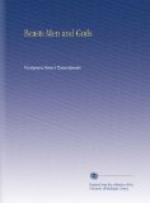Wolves and eagles are the servants of Jagasstai, the Mongol very seriously instructed us. However, this does not prevent the Mongols from hunting them. Once in the camp of Prince Baysei I witnessed such a hunt. The Mongol horsemen on the best of his steeds overtook the wolves on the open plain and killed them with heavy bamboo sticks or tashur. A Russian veterinary surgeon taught the Mongols to poison wolves with strychnine but the Mongols soon abandoned this method because of its danger to the dogs, the faithful friends and allies of the nomad. They do not, however, touch the eagles and hawks but even feed them. When the Mongols are slaughtering animals they often cast bits of meat up into the air for the hawks and eagles to catch in flight, just as we throw a bit of meat to a dog. Eagles and hawks fight and drive away the magpies and crows, which are very dangerous for cattle and horses, because they scratch and peck at the smallest wound or abrasion on the backs of the animals until they make them into uncurable areas which they continue to harass.
CHAPTER XXI
THE NEST OF DEATH
Our camels were trudging to a slow but steady measure on toward the north. We were making twenty-five to thirty miles a day as we approached a small monastery that lay to the left of our route. It was in the form of a square of large buildings surrounded by a high fence of thick poles. Each side had an opening in the middle leading to the four entrances of the temple in the center of the square. The temple was built with the red lacquered columns and the Chinese style roofs and dominated the surrounding low dwellings of the Lamas. On the opposite side of the road lay what appeared to be a Chinese fortress but which was in reality a trading compound or dugun, which the Chinese always build in the form of a fortress with double walls a few feet apart, within which they place their houses and shops and usually have twenty or thirty traders fully armed for any emergency. In case of need these duguns can be used as blockhouses and are capable of withstanding long sieges. Between the dugun and the monastery and nearer to the road I made out the camp of some nomads. Their horses and cattle were nowhere to be seen. Evidently the Mongols had stopped here for some time and had left their cattle in the mountains. Over several yurtas waved multi-colored triangular flags, a sign of the presence of disease. Near some yurtas high poles were stuck into the ground with Mongol caps at their tops, which indicated that the host of the yurta had died. The packs of dogs wandering over the plain showed that the dead bodies lay somewhere near, either in the ravines or along the banks of the river.




